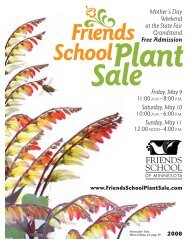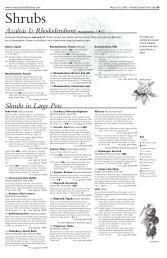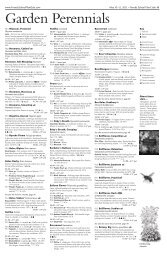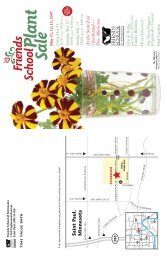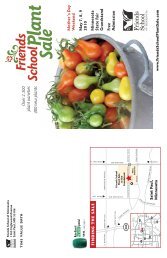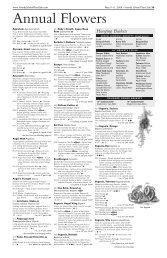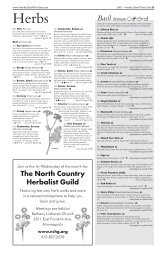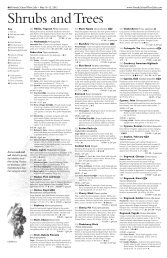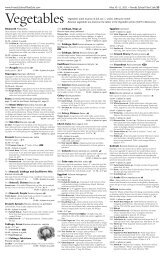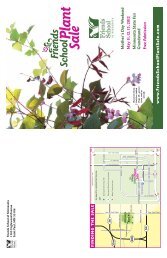2005 Catalog (PDF: 2.9MB) - Friends School Plant Sale
2005 Catalog (PDF: 2.9MB) - Friends School Plant Sale
2005 Catalog (PDF: 2.9MB) - Friends School Plant Sale
Create successful ePaper yourself
Turn your PDF publications into a flip-book with our unique Google optimized e-Paper software.
<strong>2005</strong> • <strong>Friends</strong> <strong>School</strong> <strong>Plant</strong> <strong>Sale</strong> 39<br />
Native Wild Flowers<br />
Wild Flowers of the<br />
Prairie and Savanna ˜<br />
<strong>Plant</strong>s in this section all occurred naturally in Minnesota before the onset of new species<br />
introductions that began when the first European-American farmers arrived. Many other plants are<br />
native to North America, and even the upper Midwest, but not to Minnesota. We have chosen to<br />
locate those plants in our Perennial section.<br />
For customers who want plants of local origin, the location where the plant stock or seed used<br />
to grow these plants came from is given, if known. Many of these are first-season seedlings that will<br />
stay quite small their first year while they work on developing their root systems, not blooming<br />
until their second season in the garden.<br />
N001 Angelica Angelica atropurpurea ◊<br />
A stout herb. Grows in low ground and makes<br />
a striking picture. Great for a rain garden.<br />
Glossy leathery foliage with white umbels in<br />
late summer. Seed from Pepin County, Wis.<br />
To 60” ÍÂ —in a 2.5” pot $1.00<br />
N002 Anise Hyssop<br />
Agastache foeniculum<br />
Very fragrant purple flowers July-August.<br />
Attracts butterflies and goldfinches favor the<br />
seeds. Aromatic leaves used for tea. Vigorous.<br />
Seed from Columbia County, Wis. 24–48”<br />
Í∏´Ç —in a 4” pot $3.00<br />
N003 Aster, New England<br />
Aster novae-angliae<br />
Lavender, pink and violet blossoms in fall.<br />
Tolerant of wet soil, but happy in average soil.<br />
Rare in New England, despite its name. Fair<br />
for butterflies. Seed from Winona County,<br />
Minn. 24–60” Í∏ —in a 4” pot $3.00<br />
N004 Aster, Sky Blue Aster azureus ◊<br />
One of your best bets for late season beauty<br />
and drama. With a bloom season of 2 months<br />
in August, September and October, dozens of<br />
1” lavender to deep blue, yellow-eyed daisies<br />
are held in large sprays (10-25 in a bunch)<br />
atop branching stems. Very appealing in<br />
almost any garden setting, it’s also a good nectar<br />
source for many butterflies and bees.<br />
Thrives in dry soil but is even more gorgeous<br />
in rich garden soil. Seed from Winona County,<br />
Minn. 12-48” Í∏ —in a 4” pot $3.00<br />
N005 Aster, Smooth Blue Aster laevis<br />
One of the most versatile, attractive, and<br />
longest-lived of all the asters. The attractive<br />
blue-green foliage is silky smooth, and the<br />
blue flowers appear in unbridled profusion late<br />
in the season when few other plants dare risk<br />
the danger of frost. Thrives in dry, medium<br />
and slightly damp situations. <strong>Plant</strong> in full sun<br />
for a stunning floral display. Seed from<br />
Winona County, Minn. 36–60” Í∏<br />
—in a 4” pot $3.00<br />
N006 Beardtongue, Large-flowered<br />
Penstemon grandiflorus<br />
Sculptural lavender blooms early summer over<br />
gray-green basal foliage. Prefers a dry spot.<br />
Seed from Faribault County, Minn. 24-40” Í<br />
—in a 4” pot $3.00<br />
N007 Bellflower, Tall<br />
Campanula americana<br />
Blue star flowers on tall spikes in late summer,<br />
not bell-like. Self-seeding biennial, not weedy<br />
like the ubiquitous European Creeping<br />
Bellflower. Seed from Clayton and Allamakee<br />
Counties in Iowa. 24–72” Í∏<br />
—in a 4” pot $3.00<br />
N008 Bergamot, Wild Monarda fistulosa<br />
Fragrant member of the Mint Family with<br />
lavender blossoms July-September. Smells like<br />
it belongs in Southern Europe, but thoroughly<br />
native. Excellent for butterflies and moths,<br />
attracts hummingbirds. Aromatic. Good for<br />
tea. Infuse in baths. Does better in lean soil.<br />
Grows well with Black-eyed Susan. Spreads to<br />
48”. Seed from southeastern Minnesota and<br />
northeastern Iowa. 24–48” ÍÇ<br />
—in a 4” pot $3.00<br />
N009 Black-Eyed Susan Rudbeckia hirta<br />
The biennial original. Seed from Iowa. Í∏<br />
—in a 4” pot $3.00<br />
N010 Black-Eyed Susan, Sweet<br />
Rudbeckia subtomentosa<br />
Taller cousin of the famous Black-eyed Susan.<br />
Produces large yellow flowers with shimmering<br />
red-brown centers. Large mound blooms<br />
in August-October. Truly an outstanding<br />
perennial. Attracts butterflies. 24–36” Seed<br />
from central Illinois. Í∏ —in a 4” pot $3.00<br />
N011 Blazing Star, Button Liatris aspera<br />
Tufts of lavender flowers loosely line the<br />
24–36” flowering stems creating a showy<br />
flower spike. Absolutely guaranteed to attract<br />
butterflies. Seeds eaten by birds. Protect bulbs<br />
from rodents. Blooms August to September.<br />
Quite adaptable. Seed from Whiteside County,<br />
Illinois. Í∏ —in a 4” pot $3.00<br />
N012 Blazing Star, Meadow<br />
Liatris ligulistylus<br />
Tall stalks, purple blossoms. Looks very much<br />
like the garden variety liatris, but preferred by<br />
butterflies. Seeds eaten by birds. Seed source<br />
unknown. 36–60” Í∏ —in a 4” pot $3.00<br />
N013 Blazing Star, Prairie<br />
Liatris pycnostachya<br />
Also called Kansas Gayfeather. Densely clusterd<br />
basal leaves, hairy stems, and dense<br />
flower spikes of bright purple from midsummer<br />
to early autumn. Prefers dry, sandy, welldrained<br />
soil. Seed from southeastern<br />
Minnesota. 24–48” Í∏ —in a 4” pot $3.00<br />
N014 Blue-Eyed Grass<br />
Sisyrinchium campestre<br />
Delicate, late-spring bloomer. Looks like grass,<br />
but it’s not, and the small blue blooms help to<br />
remind you. Seed from Pierce County, Wis.<br />
12” Í∏ —in a 4” pot $3.00<br />
N015 Brown-Eyed Susan<br />
Rudbeckia triloba<br />
Yellow flowers with jet black centers July-<br />
October. Easy to grow, blooms second year.<br />
Perennial, but short-lived. Self-sows. Attracts<br />
butterflies. Hundreds of blooms. Use this<br />
plant to create some major excitement in your<br />
landscape. Seed from Houston County, Minn.<br />
24–60” Í∏ —in a 4” pot $3.00<br />
N016 Butterfly Weed Asclepias tuberosa<br />
Clusters of bright orange flowers followed by<br />
puffy seed pods. Best in dry soils and full sun.<br />
Very attractive to butterflies. Late to break<br />
dormancy in spring, so mark the spot where<br />
you plant it! Seed from McLeod County, Minn.<br />
24” Í∏ —in a 4” pot $3.00<br />
N017 Cardinal Flower Lobelia cardinalis<br />
Scarlet blossoms in sun or shade. Best in partial<br />
shade or moist rich soil. Seed from<br />
Allamakee County, Iowa. 24–36” Í∏<br />
—in a 4” pot $3.00<br />
Columbine, Wild Aquilegia canadensis<br />
Red and yellow blossoms in late spring. Easy<br />
to grow. Our most popular wildflower.<br />
Excellent nectar source for hummingbirds.<br />
Does well in dappled shade. Good for edge of<br />
woodland or partly shaded hillside. Does well<br />
in moist or dry, flower border, or rock garden.<br />
8-24” ∏Ó´‰<br />
N018 Seed from Ramsey County, Minn.<br />
—in a 4” pot $3.00<br />
N019 Seed from Nebraska.<br />
—six plants in a pack $6.00<br />
—see also the yellow cultivar, page 29<br />
N020 Compass <strong>Plant</strong> Silphium laciniatum<br />
Yellow flowers June-September with huge<br />
leaves that point north and south. Tolerates<br />
drier soils. An excellent choice for a large-scale<br />
wildflower garden. Fair for butterflies. Seed<br />
from central Illinois. 36–120” Í∏<br />
—in a 4” pot $3.00<br />
N021 Coneflower, Narrow-leafed<br />
Echinacea angustifolia<br />
Large pink daisies with turned back petals,<br />
July. Most highly prized of the Echinaceas for<br />
its medicinal qualities. Attracts butterflies and<br />
hummingbirds. Prefers dry, sandy, welldrained<br />
soil. Seed from South Dakota. 12-24”<br />
Í∏´ —in a 4” pot $3.00<br />
N022 Coneflower, Pale Purple<br />
Echinacea pallida<br />
Lavender blooms June/July. Tolerates drier<br />
soils. Fair for butterflies. Seed from Ogle<br />
County, Illinois. 24-48” Í∏<br />
—in a 4” pot $3.00<br />
N023 Coneflower, Yellow<br />
Ratibida pinnata<br />
One of the most strikingly beautiful of all wild<br />
flowers. Large yellow flowers bloom in profusion<br />
in heat of summer. Blooms July-<br />
September. Easy to grow. Attracts butterflies.<br />
Seed from McCleod County, Minn. 36–72” Í<br />
—in a 4” pot $3.00<br />
N024 Coreopsis, Prairie<br />
Coreopsis palmata<br />
Yellow daisy-like blossoms in July. Aggressive,<br />
spreads by rhizomes to form dense patches.<br />
Common on original prairies. Easy to grow.<br />
Attracts butterflies. Tolerates dry conditions.<br />
Seed from Bremer County, Iowa. 24–36” Í∏<br />
—in a 4” pot $3.00<br />
N025 Culver’s Root<br />
Veronicastrum virginicum<br />
Big, dramatic spikes of white flowers July-<br />
August. Seed from Sherburne County, Minn.<br />
72” Í∏ —in a 4” pot $3.00<br />
Key<br />
Í Full sun<br />
∏ Part sun/part shade<br />
Ó Shade<br />
˜ Native<br />
˝ Ground Cover<br />
‰ Rock Garden<br />
´ Edible flowers<br />
 Medicinal<br />
Ç Culinary<br />
Blue-eyed<br />
Grass<br />
Wild Ones: Native <strong>Plant</strong>s, Natural Landscapers Ltd.<br />
promotes environmentally sound landscaping practices to<br />
preserve biodiversity through the preservation, restoration<br />
and establishment of native plant communities. Wild<br />
Ones is a not-for-profit environmental education and<br />
advocacy organization.<br />
The Twin Cities chapter meets monthly at Lake<br />
Nokomis Community Center, 2401 E. Minnehaha Pkwy,<br />
Minneapolis. All interested persons are welcomed; no<br />
admission. Upcoming meeting dates:<br />
Tuesday, April 19: “What You Can Do From Front<br />
Yards To Roadsides.” 6:30 p.m.—social and set-up time;<br />
7:00 p.m.—meeting begins.<br />
Tuesday, May 17: Meeting topic TBD; bi-annual plant<br />
sale. 6:30 p.m.—social and set-up time; 7:00 p.m.—meeting<br />
begins.<br />
Want more info? Try our website at www.for-wild.org<br />
or call Marty Rice 952-927-6531





